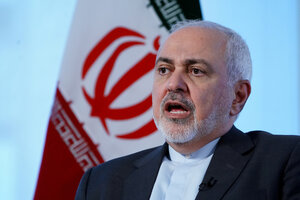Iran breaks uranium stockpile limit from 2015 deal
Iran announced June 17 it would exceed the limit, its first major breach of the deal. European leaders have met to find ways to save the deal, with U.S.-Iran tensions mounting and Iran threatening to enrich closer to weapons-grade levels.

Iranian Foreign Minister Javad Zarif speaks during an interview with Reuters, April 24, 2019. Iran has broken its stockpile limit for low-enriched uranium from the 2015 nuclear deal, Mr. Zarif announced Monday.
Carlos Allegri/Reuters
Tehran, Iran
Iran acknowledged Monday it had broken the limit set on its stockpile of low-enriched uranium by the 2015 nuclear deal, marking its first major departure from the unraveling agreement a year after the United States unilaterally withdrew from the accord.
Iran had been expected for days to acknowledge it had broken the limit after earlier warning it would do so. It held off on publicly making an announcement as European leaders met Friday in Vienna to discuss ways to save the accord. Iran has threatened to increase its enrichment of uranium closer to weapons-grade levels by July 7.
The announcement comes as tensions remain high between Iran and the U.S. In recent weeks, the wider Persian Gulf has seen Iran shoot down a U.S. military surveillance drone, mysterious attacks on oil tankers generate speculation, and Iranian-backed rebels in Yemen launch bomb-laden drones into Saudi Arabia.
The state-run IRNA news agency quoted Foreign Minister Mohammad Javad Zarif as making the uranium announcement. IRNA reported that Mr. Zarif, answering a reporter's question whether Iran had broken the limit, said: "Yes."
"If Europeans do what they have to do, our measures are reversible," Mr. Zarif said, according to IRNA.
Mr. Zarif did not say how much low-enriched uranium had on hand, IRNA said.
The United Nations' nuclear watchdog, the International Atomic Energy Agency, declined to say Monday whether Iran had broken through the limit.
"Our inspectors are on the ground and they will report to headquarters as soon as the [low-enriched uranium] stockpile has been verified," the agency said.
Breaking the stockpile limit by itself doesn't radically change the one year experts say Iran would need to have enough material for an atomic bomb, if to choose to pursue one. Iran long has insisted its nuclear program is for peaceful purposes, despite Western fears about it.
But by coupling an increasing stockpile with higher enrichment, it begins to close that one-year window and hamper any diplomatic efforts at saving the accord.
Under terms of the nuclear deal, Iran agreed to have less than 661 pounds of uranium enriched to a maximum of 3.67%. Previously, Iran enriched as high as 20%, which is a short technical step away from reaching weapons-grade levels. It also held up to 22,046 pounds of the higher-enriched uranium.
At the time of the 2015 deal, which was agreed to by Iran, the U.S., China, Russia, Germany, France, and Britain, experts believed Iran needed anywhere from several weeks to three months to have enough material for a bomb.
Mr. Zarif was quoted as also saying that the country remained on track to raise its enrichment if Europe did not take any additional steps toward saving the accord.
"The next step is about the 3.67% limitation, which we will implement too," he warned.
This story was reported by The Associated Press. Associated Press writer Kiyoko Metzler in Vienna contributed to this story.

